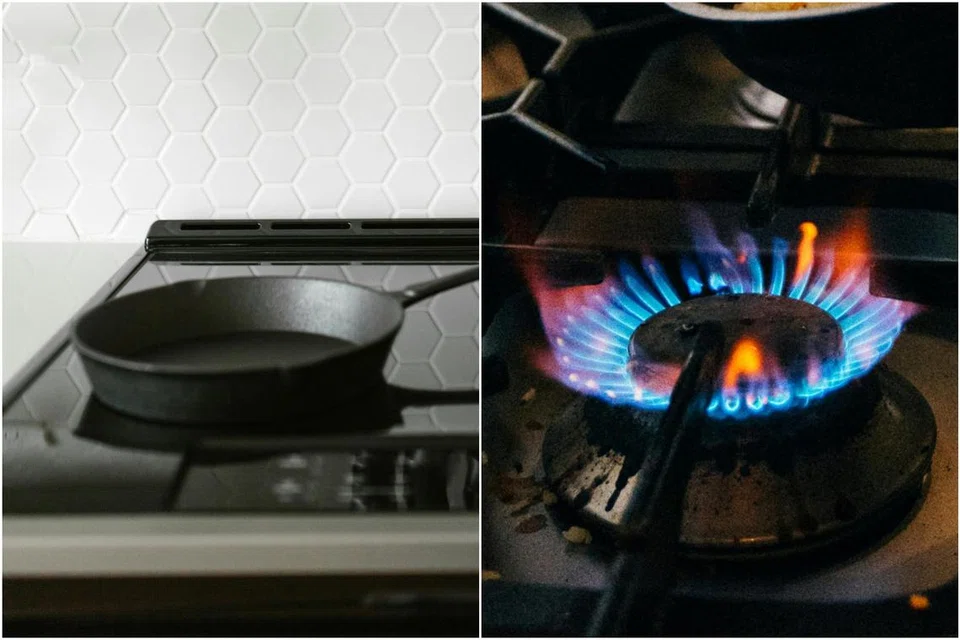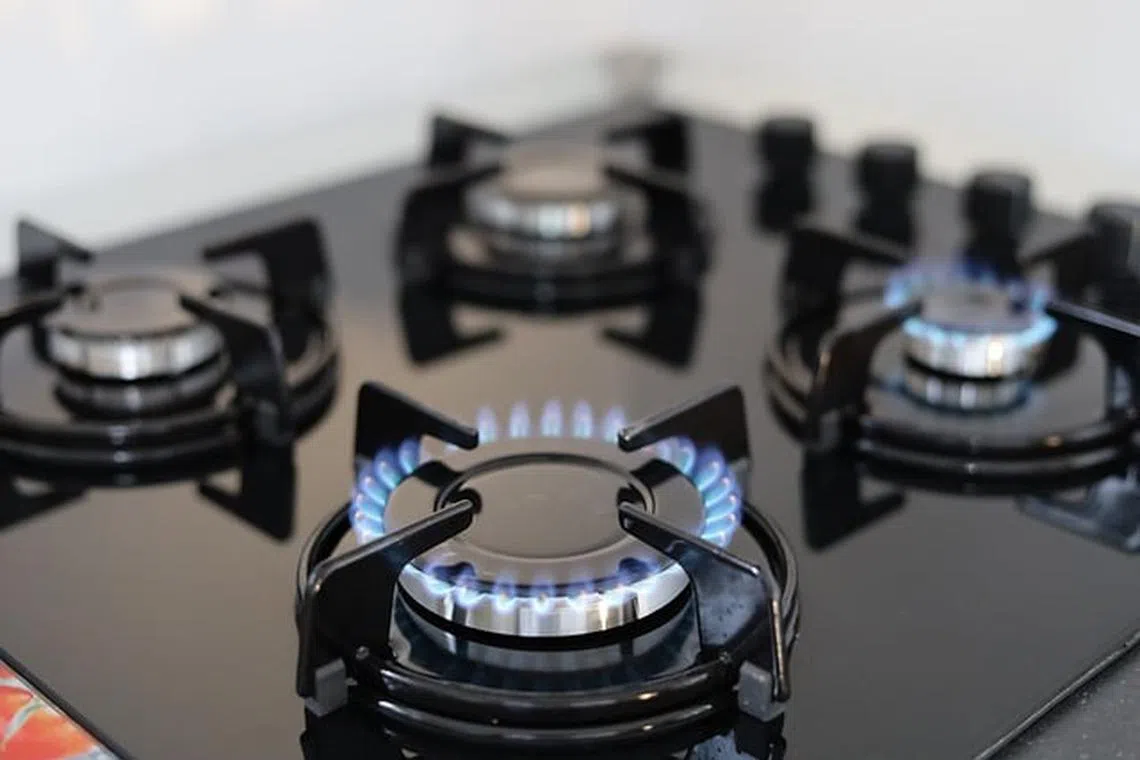askST: Induction or gas hob? Debate heats up over which one is better for your home

SINGAPORE - When fitting out a dream kitchen, one question likely to arise these days is over the type of stove top homeowners opt for: gas or hob.
For decades, there was no question that gas burners provided a quick, reliable, cost-effective and safe cooking option for kitchens all over the world.
But a sizzling debate fuelled by sustainability and health concerns has raised questions about whether it is time to replace gas burners with induction hobs.
In Britain, the Oxford City Council plans to prohibit gas hobs and boilers in new homes starting in 2025. This initiative is part of a broader goal for all new homes and buildings in Oxford to achieve net-zero carbon construction by the same year.
In the Australian state of Victoria, however, the plan to phase out gas stoves in new homes was scrapped after public backlash and concerns over electricity grid reliability and costs.
In Singapore, the push for sustainability and efficient urban living have raised similar questions.
A June 2024 report by the Energy Market Authority (EMA) said induction stoves are slowly becoming more popular due to their efficiency, safety, and likely environmental benefits.

By signing up, I accept SPH Media's Terms & Conditions and Privacy Policy as amended from time to time.

But culinary traditions in Asian cities like Singapore rely heavily on high-heat techniques like wok cooking, which means the choice between gas and induction stoves is not a clear-cut one.
Which stove is better for the environment, and why?
Dr Rob Jackson, chair of the Global Carbon Project and a professor of earth science at Stanford University, said induction stoves are the environmentally superior choice.
He told The Straits Times that induction hobs, unlike gas stoves, do not emit nitrogen dioxide or carbon monoxide - pollutants that contribute to indoor air pollution and respiratory issues.
Professor Rajasekhar Balasubramanian, Provost’s Chair Professor at the National University of Singapore’s Department of Civil and Environmental Engineering, said induction stoves operate with 80 per cent efficiency, compared with the heat-wasting nature of gas stoves, which lose much of their energy to the surroundings.
Can induction cookers handle the demands of Asian cooking?
In Singapore, the kind of Asian cooking that is popular often requires high-intensity heat and specific cooking techniques, such as that which achieves the elusive “wok hei” - a smoky, charred flavour iconic to stir-fried dishes.
Chef K.K. Kong, vice-president of the Singapore Chefs’ Association and executive chef at Sentosa Golf Club, said cooks can prepare dishes like thosai, roti prata or Chinese carrot cake effectively with induction stoves, but replicating cooking techniques to achieve, for instance the “wok hei” flavour, remains a challenge.
He said: “Induction can achieve flavours close to it, but not the same.”
However, high-power induction cookers on the market are increasingly capable of adapting to Asian cooking needs, especially for home use, Mr Kong says.
Induction surfaces, with their even heat distribution and quick heating, are especially helpful in achieving crispy textures.

Is there a difference in taste when using induction stoves versus gas stoves?
Chef Kong highlights a distinct difference in taste between the two. “Gas stoves deliver a real ‘wok hei’ and smoky aroma at high heat, akin to searing meat over charcoal.” While induction cooking excels in precision and consistency, it lacks the depth of flavour that gas stoves can achieve during high-heat stir-frying.
What about costs?
Induction stoves come with a steeper upfront price tag, including the need for compatible cookware. However, their energy efficiency leads to long-term savings.
The National Environment Agency reports that switching to induction could save households about $103 a year on utility bills.
A report on the interior design and renovation portal Qanvast said gas stoves are usually more affordable, with installation prices ranging from $200 to $1,000. Induction stoves, on the other hand, can cost anywhere from $500 to $5,000, depending on the model.
The report added that gas stoves are also compatible with a wide range of cookware, including round woks and materials like aluminium and glass, which means there is no need to invest in special cookware. However, induction stoves require cookware made from magnetic materials like steel or iron.
Are induction stoves safer and healthier for high-rise living?
In Singapore’s high-density urban environment, ventilation can be a challenge. Dr Jackson said gas stoves emit pollutants like nitrogen dioxide and benzene, which can accumulate indoors, affecting air quality not just in the user’s apartment but throughout an entire building. He added that it is similar to “standing over a car’s tailpipe”. In contrast, induction stoves do not emit pollutants, making them a healthier option for urban living.
What are the barriers to adopting induction stoves?
Retrofitting older homes with the necessary electrical infrastructure can be costly. Prof Balasubramanian said induction cookers are more expensive upfront but compensate through their long-term energy efficiency, and help cut utility bills that using a gas stove would otherwise rack up over time. He added that economic incentives or subsidies can encourage more Singaporeans to make the switch.
Could Singapore’s sustainability goals influence the gas versus induction debate?
Dr Jackson said Singapore’s push for sustainability could make induction stoves a centrepiece of future policies.
However, as more households switch to induction hobs, electricity demand will rise, and likely put a strain on the grid.
Prof Balasubramanian said one way to soften the impact of higher consumption is to integrate more renewable energy into Singapore’s power generation mix.
So, the verdict on whether to use a gas burner or induction hob boils down to making a personal and policy choice.
Both gas and induction stoves have their strengths. For traditionalists, gas offers unmatched flavour for specific dishes. For modern kitchens, induction wins with efficiency, safety, and precision. As Singaporeans weigh their options, the choice is not just about cooking - it is about sustainability, health, and adapting to the evolving culinary landscape.
Enjoying ST's content? Become a subscriber to access premium articles
Subscriber-exclusive benefits for One Digital Package:
- Access all subscriber-only content on ST app and straitstimes.com.
- Easy access any time via ST app on one mobile device.
- myST: Follow up to 30 authors and 30 topics.
Join ST's Telegram channel and get the latest breaking news delivered to you.





No comments:
Post a Comment